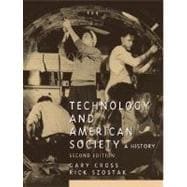
Note: Supplemental materials are not guaranteed with Rental or Used book purchases.
Purchase Benefits
What is included with this book?
Gary Cross is Distinguished Professor of Modern History at Pennsylvania State University, and a graduate of the University of Wisconsin in 1977 (Ph.D.). He has published ten books and twenty-three scholarly articles concerning the modern history of social, economic, and technological change in America, Britain, and France. Among his books are A Quest for Time: The Reduction of Work in Britain and France; Time and Money: The Making of Consumer Culture; Kids' Stuff: Toys and the Changing World of American Childhood; An All-Consuming Century: Why Commercialism Won in Modern America; and The Cute and The Cool: Wondrous Innocence and Modern American Children's Culture. These books feature the social and cultural impact of technological and economic change. Since 1981, he has taught an undergraduate course on the history of technology in America. His wife, Maru, and two children, Elena and Alex, have more or less cheerfully accompanied him on trips to numerous museums and heritage sites that feature technology.
Rick Szostak is Professor and Associate Dean of Arts at the University of Alberta, where he has taught since receiving his Ph.D. from Northwestern University in 1985. He is the author of eight books and more than twenty scholarly articles in the fields of the history of technology, economics, and interdisciplinary theory and practice. His books include The Role of Transportation in the Industrial Revolution, which showed how eighteenth-century transport improvements encouraged both the rise of the factory and a dramatic increase in the rate of technological innovation, and Technological Innovation and the Great Depression, which argued that much of that calamity could be attributed to the lack of new product innovation in the decade after 1925, combined with an abundance of labor-saving technology. He has authored articles on technological subjects for the Oxford Encyclopedia of Economic History, Scribner's Dictionary of American History, and the Gale Encyclopedia of the Great Depression. As associate dean, he spearheaded the development of a new major in Science, Technology, and Society at the University of Alberta in 2004. In recent research he explores how the linkages among human science disciplines can be strengthened. His inspiration comes from his wife, Anne-Marie, and their children, Mireille, Julien, and Theodore.
| Working the Landin Preindustrial Europe and America | |
| Craftsmen in the Shop: European Traditions and American Changes in the Eighteenth Century | |
| Women and Work before the Factory | |
| Origins of Industrialization | |
| The Birth of the Factory | |
| Iron, Steam, and Rails | |
| Machines and their Mass-Production | |
| Machines on the Farm and in the Forest, 1800-1940 | |
| Americans Confront a Mechanical World, 1780-1900 | |
| The Second Industrial Revolution | |
| Technology and the Modern Corporation | |
| Technology and the First Arms Race, 1770-1918 | |
| The Impact of Technology on Women's Work | |
| The New Factory | |
| Innovation, The Great Depression, and the Automobile, 1918-1940 | |
| Mechanizing Sight and Sound | |
| Technology and the Origins of Mass Culture | |
| Airplanes and Atoms in Peace and War | |
| Our Computer Age | |
| Recent Advances in Technology | |
| Modern Americans in a Technological World | |
| Table of Contents provided by Publisher. All Rights Reserved. |
The New copy of this book will include any supplemental materials advertised. Please check the title of the book to determine if it should include any access cards, study guides, lab manuals, CDs, etc.
The Used, Rental and eBook copies of this book are not guaranteed to include any supplemental materials. Typically, only the book itself is included. This is true even if the title states it includes any access cards, study guides, lab manuals, CDs, etc.